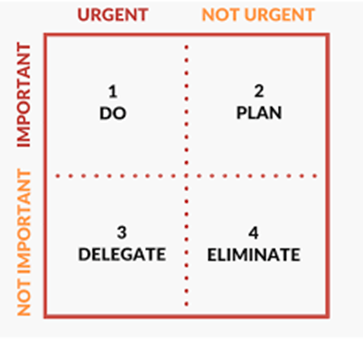Self-Accountability Part 3
A great tool to help diagnose where these problems come into play is using the four quadrants from Stephen Covey’s great book, “The Seven Habits of Highly Effective People” or sometimes called “The Eisenhower Matrix” after the famous General and President.

The quadrant is displayed at the left. Take any task that you need to perform and grade it on the two questions that follow.
- Is this urgent? – does this task require immediate attention or there will be negative consequences? Tasks that are urgent are like running water over a burned finger or paying rent on the first of the month. If you don’t handle them immediately, you’ll move significantly further from your goals.
- Is this task important? Will this specific task “move the needle” for whatever metrics you have designed in your personal development plan? This could be launching a marketing campaign for your business or applying to new jobs. The difficulty of a task can, but does not always, match the importance.
The simple nature of the matrix is intuitive and easy to use, especially if you have experience running a team.
The important and urgent (quadrant 1) is something you personally need to do immediately. This is the CEO returning the calls of the company’s attorneys: you don’t want the summer intern in charge of that, and you don’t wait until 3 months to call them back.
The important but not urgent (quadrant 2) means you personally need to plan out where the process is going. When a home builder sells a home, one of the first steps is planning all of the components and craftsmen necessary to get the entire project done. If windows are on a 3 month lead time, not the usual 2 weeks, that’s not a problem the day the house is sold, but it’s an incredibly serious problem a month before turning the house over to the new owners. Taking that time to plan out what could turn from just important into important and urgent, and preventing those problems from happening is a huge return from a time perspective.
Next is the urgent, but not important in quadrant 3. This could be something like “returning a current customer’s phone call about a non-critical issue”. If a customer wants clarification on a small item, it’s not something the CEO should focus on, but would be perfect for an hourly employee to do. The focus here is to delegate what is possible, to make sure you’re getting the best use of your time. Remember that as long as the task is done, you’re successful.
Finally we have quadrant four, the least important and least urgent tasks. These are the easiest traps to fall into on your path to success, and eliminating these tasks completely is the goal.
When entrepreneurs get started building their businesses, this is where so many get stuck in the mud: they want business cards, and logos, and talk about “what the company culture will be like”. Those tasks are great ways to avoid having to do the most important and urgent task entrepreneurs have: getting new, paying clients.
– Jim Koch, the man who created the Boston Beer Company, best known for their Samuel Adams beer line, had a great story about when he was starting out. He had picked out the perfect logo, was looking at office space and had his eye on a massive computer system to handle processing all the orders he’d have.
– The trouble was, he had zero orders. A family member who was an investor and had a background in finance finally sat him down and said “it doesn’t matter if you have the fanciest computer to process the orders, if you don’t have any orders to process.”
– Jim was failing to properly categorize tasks using the quadrant above. He was luckily just wasted time, and not the precious start-up money, on the unimportant and not urgent tasks. After the conversation with the family member, he went into a bar with a six pack, sold his first few cases and now employs around 2000 people, generating over one billion dollars per year in revenue
– Imagine what would have happened if he didn’t talk to the experienced family member? He could have spun his wheels for years, designing letterhead and who knows what other useless task, while the empire of Boston Beer Company faded away.
The entire American craft brewing renaissance might not have happened if Jim didn’t have that one conversation – and more importantly – implement the action that was recommended.
– How are you cutting yourself short in the impact that you’re able to make to the world? That’s what the quadrant is designed to improve, not just the insight, but how you can take the insights learned into action.
– When you’re assessing your personal development plan, you can use this matrix on the front and back end, as both a planning tool and one for diagnosis of failure. If you’re finished with your whole plan, but before you implement it you do a quick check of all of the daily plans against this matrix, you can save yourself a ton of wasted time on the front end: could half of these tasks be delegated, and a quarter totally eliminated?
– Next you can use it on the back end. Take time every three months, six months, whatever interval makes sense to do an audit of your activity. Were you actually delegating the urgent but not important? Did you spend two weeks building a social media presence for a business that isn’t necessary or likely to get new clients for your small consultancy? Did you prioritize your day to solve urgent and important problems, every single day?
Use the feedback to change habits, not feel sorry for yourself, and your creativity at solving the problems will skyrocket, and so will your progress towards your goals.
Once you’ve made the plan outlined above, you’re taking the daily action necessary to meet your specific goals that are all outlined and you’re taking a look at the plan every few months to make sure you’re not focused on unnecessary things, we can consider step one completed.
The next thing we need to focus on is step two.
Continued…






